AWM41 995 - [Nurses Narratives] Sister G M Larkan - Part 2
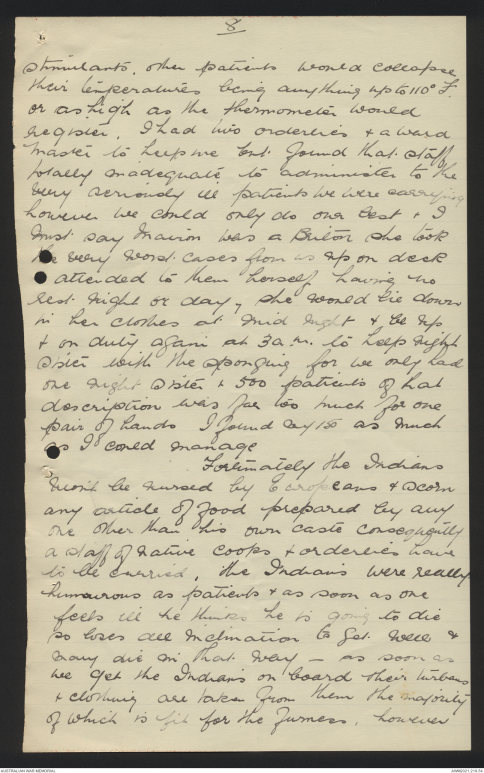
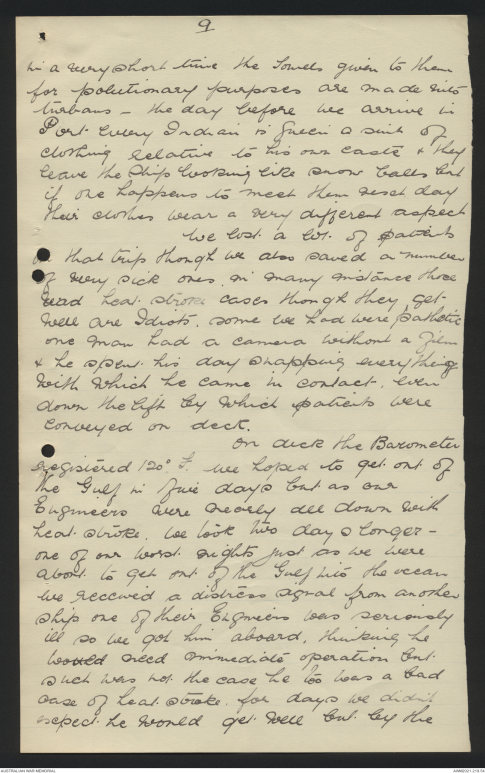
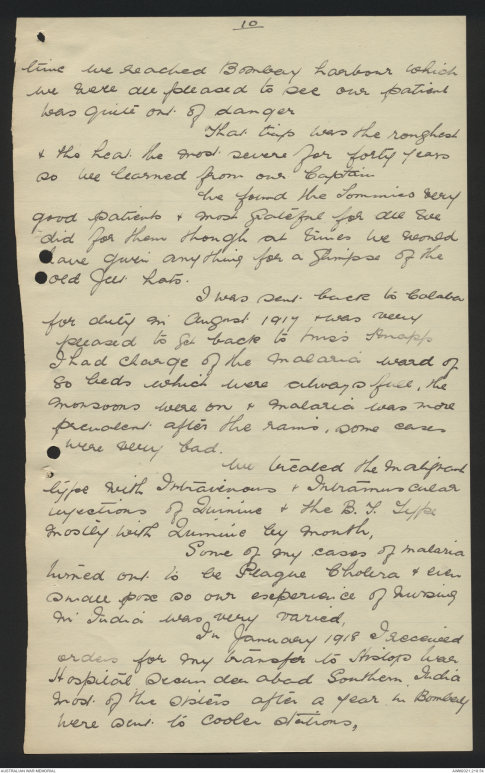
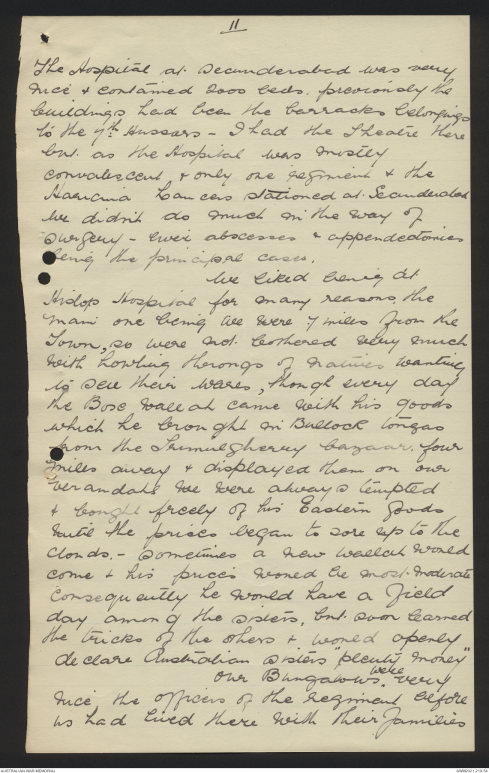
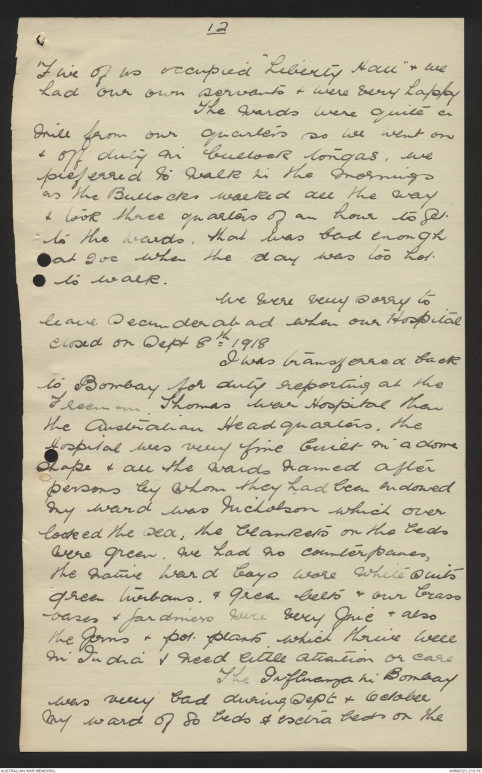
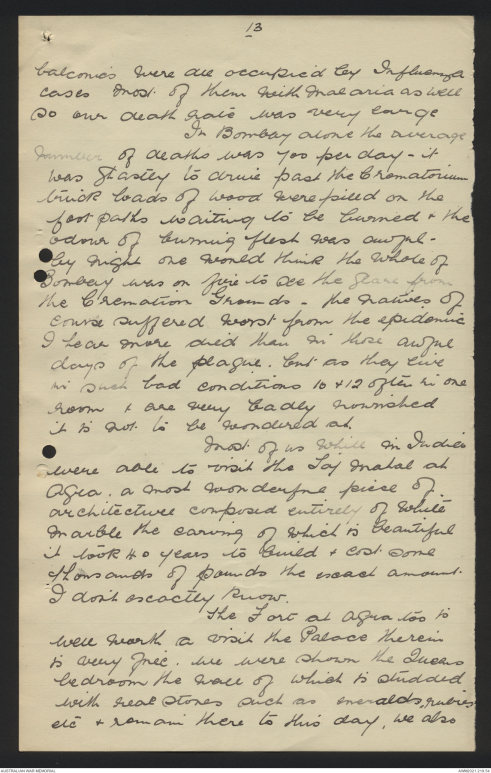

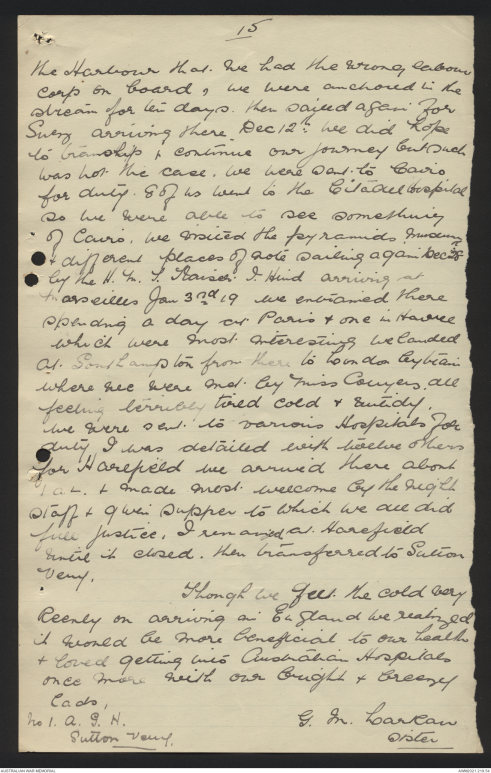
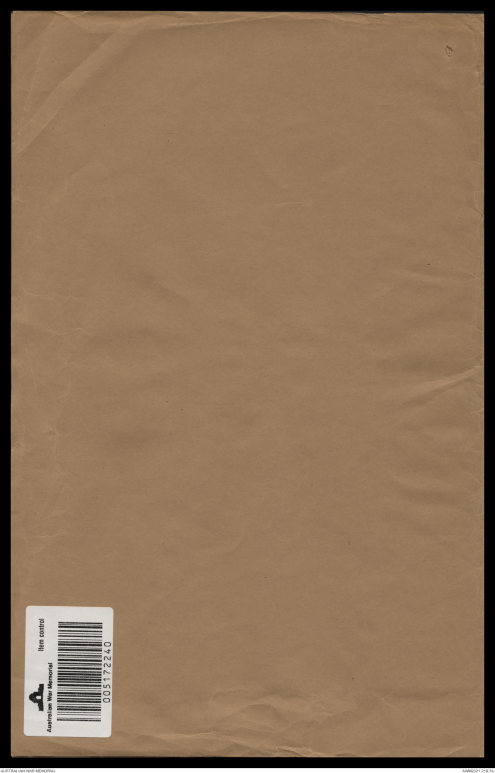
8
stimulants other patients would collapse
their temperatures being anything up to 1100 F
or as high as the thermometer would
register. I had two orderlies & a ward
master to help me but found that staff
totally inadequate to administer to the
very seriously ill patients We were carrying
however we could only do our best & I
must say Inairm was a [[?]] she took
the very worst cases from us upon deck
attended to them herself having no
rest night or day, she would lie down
in her clothes at mid night & be up
& on duty again at 3 a.m. to help night
Sister with the sponging for we only had one
night Sister & 500 patients of hat
description was far too much for one
pair of hands I found say 150 as much
as I could manage.
Fortunately the Indians
won't be nursed by Europeans & scorn
any outside of food prepared by any
one other than his own caste consequently
a Staff of native cooks & orderlies have
to be carried, the Indians were really
humurous as patients & as soon as one
feels ill he thinks he is going to die
so loses all inclination to get well &
many are on that way - as soon as
we get the Indians on board their turbans
and clothing are taken from them the majority
of which is fit for the furnace however
9
in a very short time the towels given to them
for polutionary purposes are made into
turbans - the day before we arrive in
Port every Indian is given a suit of
clothing relative to his caste & they
leave the ship looking like snow balls but
if one happens to meet them next day
their clothes wear a very different aspect.
We lost a lot of patients
that trip though we also saved a number
of very sick ones in many instance three
[[?]] heat stroke cases though they get
well are Idiots Some we had were pathetic
one man had a camera without a film
& he spent his day snapping everything
with which he came in contact even
down the lift by which patients were
conveyed on deck.
On deck the Barometer
registered 1200 F we hoped to get one of
The Gulf in five days but as our
Engineers are nearly all down with
heat stroke [[?]] took two day [[?]] longer -
one of our worst nights just as we were
about to get one of the Gulf [[?]] the ocean
we received a distress signal from another
ship one of their Engineers was seriously
ill so we got him aboard thinking he
would need immediate operation nut
such was not the case he too was a bad
case of heat stroke for days we didn't
expect he would get well but by the
10
time we reached Bombay Harbour which
we were all pleased to see our patient
was quite out of danger.
That trip was the roughest
& the heat most severe for forty years
so we learned from our Captain.
We found the Tommies very
good patients & most grateful for all we
did for them though at times we would
have given anything for a glimpse of the
old [[?]] hats.
I was sent back to Colaba
for duty in August 1917 & was very
pleased to get back to Miss [[?]]
I had charge of the Malaria ward of
80 beds which were always full, the
monsoons were on & Malaria was more
prevalent after the rains, some cases
were very bad.
We treated the [[?Malprant?]]
type with Intravenous & Intramuscular
injections of Quinine & the B. T. Type
mostly with Quinine by mouth.
Some of my cases of Malaria
turned out to be Plague Cholera & even
small pox so our experience of nursing
in India was very varied.
In January 1918 I received
orders for my transfer to Hislop War
Hospital Secunderabad Southern India
Most of the Sisters after a year in Bombay
were sent to cooler stations,
11
The Hospital at Secunderabad was very
nice & contained about 200 beds previously the
buildings had been the barracks belonging
to the 7th Hussars - I had the Theatre there
but as the Hospital was mostly
convalescent & only one regiment & the
[[?]] [[?]] stationed at Secunderabad
we didn't do much in the way of
surgery - were abscesses & appendectomies
being the principal cases.
We liked being at
Hislop Hospital for many reasons the
main one being we were 7 miles from the Town, so were not bothered very much
with howling throngs of natives wanting
to sell their wares, though every day
the Box Wallah came with his goods
which he brought in Bullock [[?]]
from the [[?]] [[?]] Bazaar four
miles away & displayed them on our
verandah We were always tempted
& bought freely of his Eastern Goods
until the prices began to sore up to the
clouds - sometimes a new Wallah would
come & his prices would be most moderate
Consequently he would have a field
day among the Sisters, but soon learned
the tricks of others & would openly
declare Australian Sisters "plenty money"
Our Bungalows ∧were very
nice the officers of the regiment before
us had lived there with their families
12
Five of us occupied "Liberty Hall" & we
had our own servants & were very happy
The wards were quite a
mile from our quarters so we went on
& off duty in bullock [[?]] , we
preferred to walk in the mornings
as the Bullocks walked all the way
& took three quarters of an hour to get
to the wards, that was bad enough
[[?that?]] [[?]] when the day was too hot
to walk.
We were very sorry to
leave Secunderabad when our Hospital
closed on Sept 8th 1918
I was transferred back
to Bombay for duty reporting at the
[[?Freeman?]] Thomas War Hospital than
the Australian Headquarters. The
Hospital was very fine quiet in a dome
shape & all the wards named after
persons by whom they had been endowed
My ward was Nicholson which over
looked the sea, the blankets on the beds
were green. We had no counterpanes,
the native Ward boys wore white suits
green turbans, & green belts & our brass
vases & [[?jardmers?]] were very[[?]] & also
the [[?]] & pot plants which thrive well
in India & need little attention or care.
The Influenza in Bombay
was very bad during Sept & October
My ward of 80 beds & extra beds on the
13
balconies were all occupied by Influenza
cases most of them with Malaria as well
so our death rates was very large
In Bombay alone the average
number of deaths was 700 per day - it
was ghastly to drive pass the Crematorium
truck loads of wood were piled on the
foot paths waiting to be burned & the
odour of burning flesh was awful -
by night one would think the whole of
Bombay was on fire to see the flare from
the Crematorium Grounds - the natives of
course suffered worst from the epidemic
I hear more died than in those awful
days of the plague but as they live
in such bad conditions 10 & 12 often in one
room & are very badly nourished
it is not to be wondered at.
Most of us while in India
were able to visit the Taj Mahal at
Agra, a most wonderful piece of
architecture comprised entirely of white
marble the carving of which is beautiful
it took 40 years to build & cost some
thousands of pounds the exact amount
I don't exactly know.
The Fort at Agra too is
well worth a visit the Palace therein
is very free. We were shown the Queens
bedroom the wall of which is studded
with real stones such as emeralds, rubies
etc & remain there to this day, we also
14
saw her bath of white marble in the
centre of which is a rose water foundation
with a spray.
From Agra we went by
the Himalaya Mountains which were
very beautiful & very steep we were
carried in chair size arrangements known
as [[?]] with a pole back & front
& carried by four [[?coolies?]] in front & four
behind, a distance of 7 miles to a place
known as [[?]] a beautiful hill
station where we were to spend our leave
there were hundreds of monkeys in the trees
& baboons many with long beards
the walks though the Hills were very
pretty & most interesting we had
Rickshaws from which we could view
the surrounding country if we wished
In Nov 1918 we learned with
delight we were to be transferred from
India to the United [[?]] for duty
in many ways we had regrets leaving
India but after two years there most of us
feel a change would be most acceptable
as a great majority of us suffered
with that dreaded disease Malaria
we sailed by the H. M. T. Royal George
on Nov 18th & after 4 days at sea we got
a wireless from Aden to proceed back
to Bombay - none of us knew why but
numerous rumours went about the Ship
however we learned on our arrival in
15
the Harbour that we had the wrong labour
corp on board, we were anchored in the
stream for ten days then sailed again for
Suez arriving there Dec 12th we did hope
to tranship & continue our journey but such
was not the case. We were sent to Cairo
for duty 8 of us went to the Citadel Hospital
so we were able to see something
of Cairo, we visited the pyramids [[?]]
& different places of note sailing again Dec 28
by the H. M. T. Kaiser I. Hind arriving at
Marseilles Jan 3rd 19 we entrained there
spending a day at Paris & one in Havre
which were most interesting we landed
at Southampton from there to London by train
where we were met by Miss Couyers all
feeling terribly tired cold & untidy
we were sent to various Hospitals for
duty I was detailed with twelve others
for Harefield we arrived there about
1 a.m. & made most welcome by the night
staff & given supper to which we all did
full justice, I remained at Harefield
until it closed, then transferred to Sutton
Veny.
Though we feel the cold
keenly arriving in England we realized
it would be more beneficial to our health
& loved getting into Australian Hospital
once more with our bright & cheery
lads.
G. M. Larkan
Sister
[[?M?]]. I. A. G. N.
Sutton Veny
Item control
Australian War Memorial
(Barcode)
005172240
 Marj Moodie
Marj MoodieThis transcription item is now locked to you for editing. To release the lock either Save your changes or Cancel.
This lock will be automatically released after 60 minutes of inactivity.